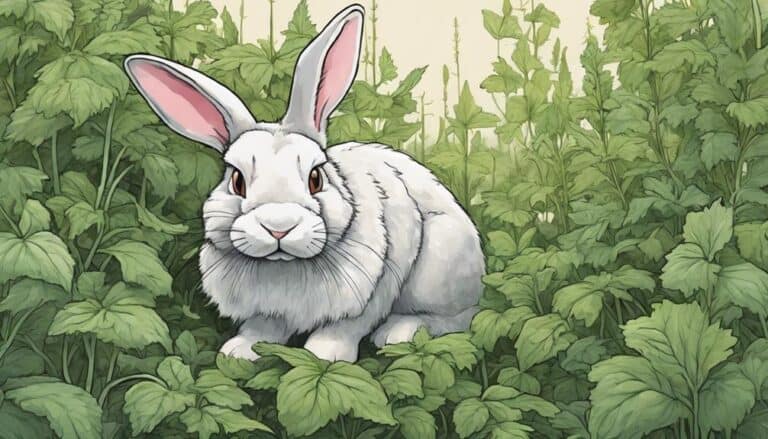Have you ever wondered where rabbits go when you get close to them? The answer might surprise you. These animals are experts at hiding, and they use all sorts of natural hiding spots to stay out of sight.
From complex networks of underground tunnels to cleverly hidden burrows under bushes, rabbits are great at blending in with their surroundings.
So, next time you see a rabbit darting away, think about the secret places they hide and the skills that keep them safe.
Contents
Key Takeaways
So, where do rabbits hide? Well, one of their favorite spots is underground in burrows. This is a great place for them to feel safe and protected.
When they're above ground, rabbits like to seek shelter in dense vegetation, like thick bushes or tall grass. This helps them avoid predators that might be lurking around.
Rabbits also love to curl up in cozy retreats like hollow logs. These make perfect hiding spots, and they’re nice and quiet too. In addition to their cozy retreats, rabbits often seek shelter in dense vegetation during inclement weather. Observing rabbits behavior in rainy weather reveals their adaptability; they might stay sheltered for hours, only venturing out when the rain subsides. This instinctual behavior not only keeps them safe from predators but also helps them conserve energy when conditions are less than ideal.
But what about when they're out in the open? That's when they rely on their amazing camouflage skills. They can blend in with their surroundings so well that it's hard to spot them!
As for domestic rabbits, they like to use boxes and tunnels as hiding spots. These provide them with a sense of security and comfort in their own little world.
Natural Hiding Spots for Rabbits
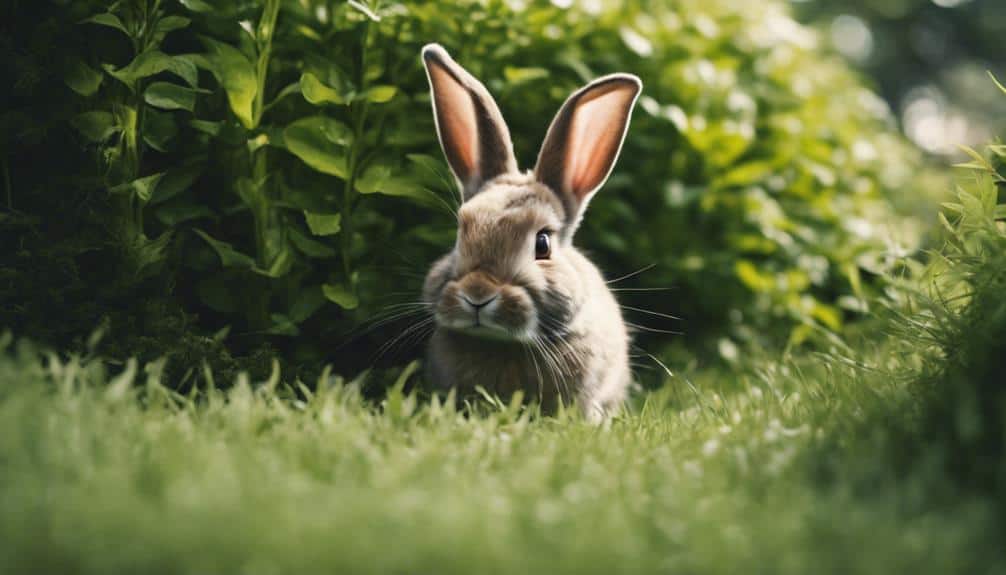
Rabbits have an instinct to hide in natural spots like burrows, dense vegetation, or hollow logs to protect themselves from predators.
These clever animals use their surroundings to stay safe and survive in the wild.
Burrows, which rabbits often dig themselves, provide a safe place for them to rest, raise their young, and hide from potential threats.
These underground tunnels are like a secret network of passageways that offer protection and camouflage.
Dense vegetation, like thick bushes or shrubs, creates a natural barrier that hides rabbits from view, allowing them to avoid detection by predators.
Hollow logs offer a cozy retreat where rabbits can seek refuge, blending in with their surroundings.
Underground Tunnel Systems
Rabbits are experts at digging, and their underground tunnel systems are a crucial part of their survival strategy in the wild.
These tunnels, which they dig themselves, provide shelter, protection, and a network for storing food and escaping from predators. Because of their small size and impressive digging skills, rabbits can create a complex maze of interconnected tunnels that can stretch several feet underground.
One of the main reasons rabbits build these tunnel systems is to avoid predators.
They also use them to raise their young and regulate their body temperature. The tunnels usually have multiple entrances and exits, so rabbits can quickly get to safety if they sense danger.
Additionally, these systems often have separate areas for nesting, storing food, and disposing of waste, which helps keep the burrow clean.
The fact that the tunnels are interconnected allows rabbits to move around their environment safely and efficiently.
Shallow Burrows Under Bushes
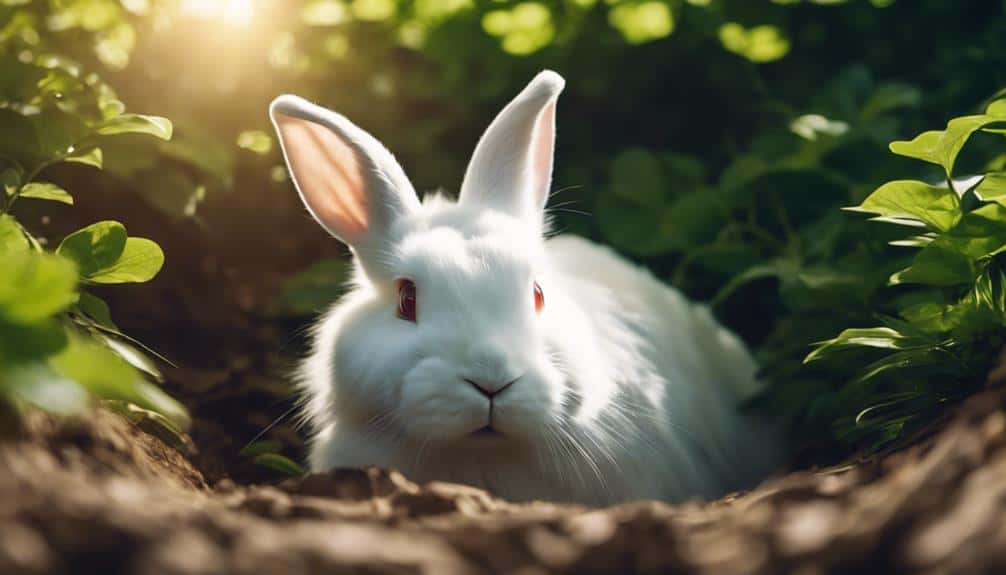
Rabbits are super smart about where they build their homes. They dig shallow burrows under bushes to stay safe from predators and harsh weather. The spot they choose is really important for their survival.
These burrows are usually found in dense, thorny areas that offer extra protection. The rabbits line their hiding spots with stuff that keeps them warm and hidden from danger.
This is really important for them to stay safe.
Bushes as Rabbit Shelter
In the thick of the bushes, you can find a network of shallow burrows that provide wild rabbits with a safe haven. These burrows are like temporary hideouts for rabbits that need to escape from predators or bad weather. Inside these burrows, rabbits often build a cozy nest made of dried grass, twigs, and their own fur to keep warm and comfortable.
The bushes are perfect for rabbits because they blend in so well with their surroundings, making it hard for predators to spot them. Rabbits usually dig these shallow burrows close to a reliable food source, so they can grab a quick bite to eat while staying safe from harm.
Watching these rabbits in their natural habitat is really fascinating. The way they strategically place their burrows under bushes shows how well they've adapted to their environment.
When the sun starts to set and the rabbits come out of their shelters, you can appreciate how they balance being vulnerable with being resilient in the wild.
Burrow Location Strategy
Wild rabbits are experts at hiding from predators and harsh weather. They dig shallow burrows under dense bushes, which provide a perfect hiding spot. The branches and leaves of the bush camouflage the entrance, making it hard for predators to find.
Rabbits prefer to dig their burrows under bushes with low-hanging branches, like hostas or burning bushes. These branches add an extra layer of protection.
The burrows are usually only 2-3 feet deep and have multiple exits. This way, if a predator finds the burrow, the rabbit can quickly escape.
By living in these shallow burrows under bushes, rabbits are less likely to be seen by predators. This helps them survive, especially during the harsh winter months.
Rabbits are very good at adapting to their environment and finding ways to stay safe. They're able to do this because of their strong survival instincts.
Dense Vegetation as Shelter
Rabbits manage to stay safe from predators largely due to dense vegetation serving as an effective shield for them. This natural camouflage adaptation allows them to blend seamlessly into their surroundings.
When rabbits are in danger, they can rely on dense vegetation to provide a safe refuge. The intricate patterns of leaves and branches offer them a crucial sanctuary, which is a great example of nature's protective mechanisms at work.
Vegetation as Cover
Rabbits have a few tricks up their sleeves to stay safe and hidden, but one of the most important is using dense vegetation as a shelter.
During the winter, when it's cold and food is scarce, they really rely on vegetation cover to protect them from the harsh conditions.
You see, small animals like rabbits are super good at slipping through thick bushes and undergrowth to find a safe spot to hide from predators and bad weather.
Dense vegetation gives rabbits a cozy little haven where they can rest, eat, and take care of their babies without being bothered.
The tangled network of branches, leaves, and shrubs acts like a natural shield, making these little creatures almost invisible as they blend in with their surroundings.
This cover not only keeps them safe from predators, but it also helps them stay warm when it's cold outside.
In their fight to survive, rabbits show just how adaptable they're by using vegetation cover as a clever way to defend themselves against the harsh elements and potential dangers in their environment.
Natural Camouflage Adaptation
Rabbits have a natural camouflage adaptation that helps them blend in with their surroundings. They use thick vegetation to hide from predators and harsh weather. This is especially important when they need to protect their vulnerable baby rabbits.
Their fur often matches the colors of the plants around them, making it hard for predators to spot them even when they're close by. This is called color matching.
When rabbits sense danger, they freeze and remain silent, looking just like a part of the vegetation. This helps them avoid detection. They're really good at staying still and quiet!
Rabbits also strategically position themselves under bushes or in thickets, taking advantage of the natural cover to stay hidden from threats. And if they need to, they can quickly dart into the dense vegetation, disappearing from sight in seconds. This is super helpful in case of an emergency!
Hiding in Plain Sight Strategies
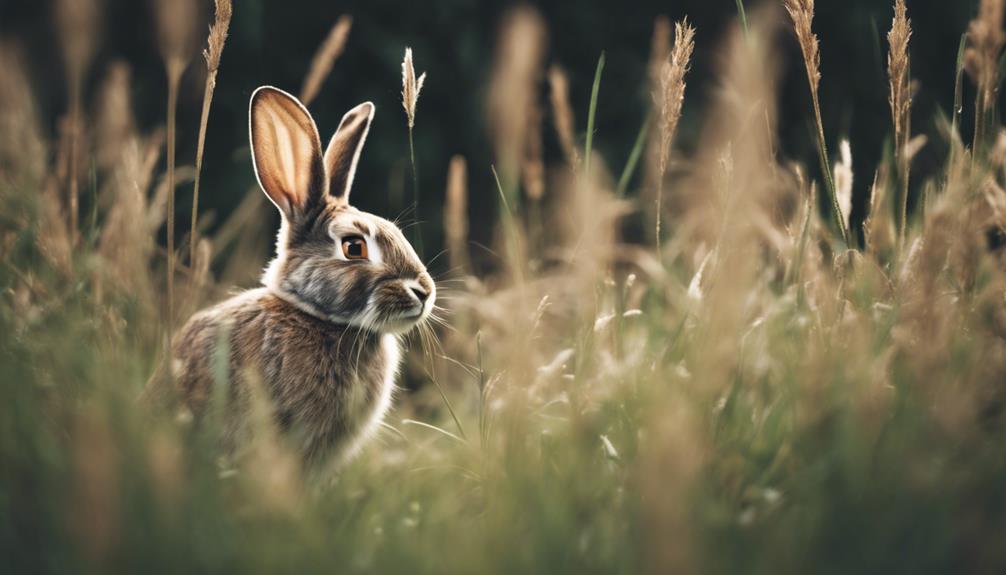
Rabbits are masters of hiding in plain sight. When they sense danger, they can freeze in place, relying on their fur color to blend in with their surroundings. This tactic is especially effective during winter when their white coats help them merge with the snow. As a result, they can avoid predators like foxes and birds of prey.
But that's not all. Rabbits also use their small size to their advantage. They'll hide among bushes, tall grass, or rocks, staying perfectly still and tucking themselves into nooks and crannies. This behavior makes them nearly invisible to the untrained eye. Not only does it help them avoid danger, but it also allows them to conserve energy during times of scarcity.
Rabbits' ability to blend in with their surroundings is a remarkable adaptation to their environment. Their strategic use of natural camouflage is a crucial defense mechanism that enables them to survive in the face of various challenges posed by their habitats.
Utilizing Man-Made Hiding Places
Man-made hiding places are super important for rabbits. They need extra shelter and protection from potential threats in their environment. When it comes to pet rabbits or domestic rabbits, creating suitable hiding spots within their living space can greatly benefit their well-being.
Rabbits often enjoy hiding in cardboard boxes, which provide them with a cozy and secure space to retreat to when they feel stressed or scared. It's like having a little fort to hide in!
Providing tunnels and tubes for rabbits to explore and hide in can mimic their natural burrowing instincts, offering them a sense of security and enrichment in their environment. They love to dig and burrow, so having tunnels and tubes to play with is like a dream come true!
Small huts or hideaways made of safe materials can serve as ideal hiding spots for rabbits, allowing them to have a secluded area to rest and relax. It's like having their own little bedroom!
Rabbits may also seek refuge under furniture, such as beds or sofas, where they can feel protected while still being part of the household environment. They love to squeeze into tight spaces and feel safe, so under-furniture spaces can be a great option!
Shelter Options for Wild Rabbits
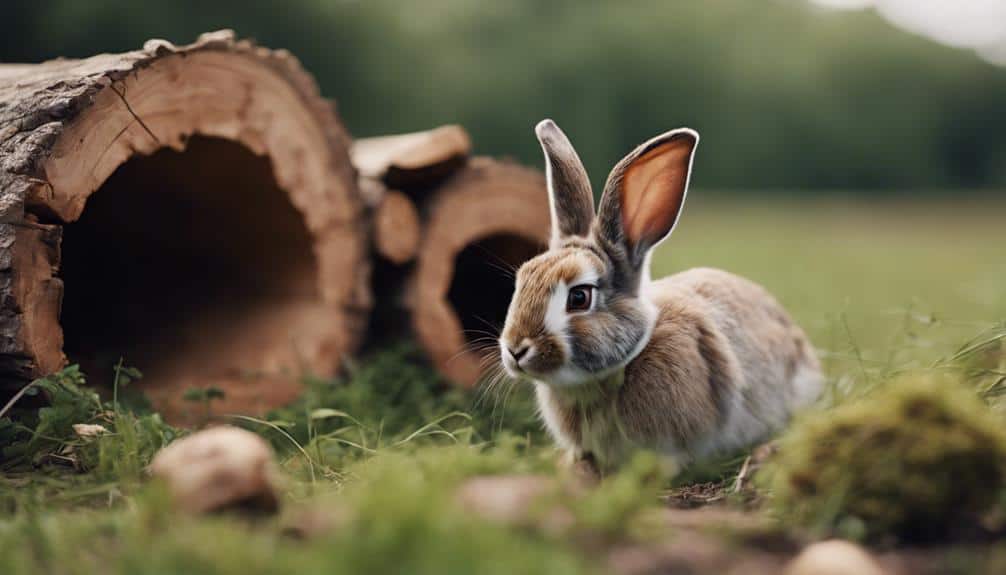
Wild rabbits need shelter to survive, especially during harsh winter months. Their dense fur coat helps keep them warm, but they also rely on various shelter options to protect themselves from predators and the elements.
One of their go-to shelters is burrows. These underground tunnels are like safe houses for rabbits. They're protected from extreme temperatures and predators, and the rabbits can dig multiple entrances for easy escape routes. Burrows are like cozy little homes where rabbits can huddle together for warmth and safety.
But burrows aren't the only shelter option for wild rabbits. They also seek out dense vegetation or brush piles. These natural shelters block wind, rain, and snow, and rabbits can create warm, dry nests using grass, leaves, and their own fur.
Winter Survival Tactics for Rabbits
When winter rolls around, rabbits have to get creative to survive the harsh conditions and find food. One of the ways they adapt is by seeking shelter in insulated underground dens during extreme cold weather. In warmer seasons, they venture back to their usual food spots.
Rabbits are actually pretty comfortable in cold temperatures, feeling cozy even as low as 32 degrees Fahrenheit. During winter, they're more active in their search for food and aren't as picky about what they eat.
To combat the chill, rabbits grow a thick fur coat in the fall. Their body temperature ranges from 101-103 degrees Fahrenheit, which enables them to withstand temperatures as low as freezing.
During winter, rabbits often take shelter in yards that offer both food and hiding spots. They make use of insulated dens and natural shelters to keep warm, often choosing yards with ample food sources nearby. When vegetation is scarce, they adjust their diets to include rougher items like bark and pine cones.
Conclusion
Rabbits are super good at finding clever hiding spots in nature to avoid predators. They really take the phrase 'out of sight, out of mind' to heart.
Their go-to hiding spots include underground burrows, dense vegetation, and hollow logs. These spots allow them to stay safe and thrive in the wild.
Rabbits have natural instincts and adaptive behaviors that help them blend in with their surroundings. This makes them really hard to spot, even for people who are looking for them.
So, the next time you're out in the wilderness, keep an eye out for these expert hiders!

